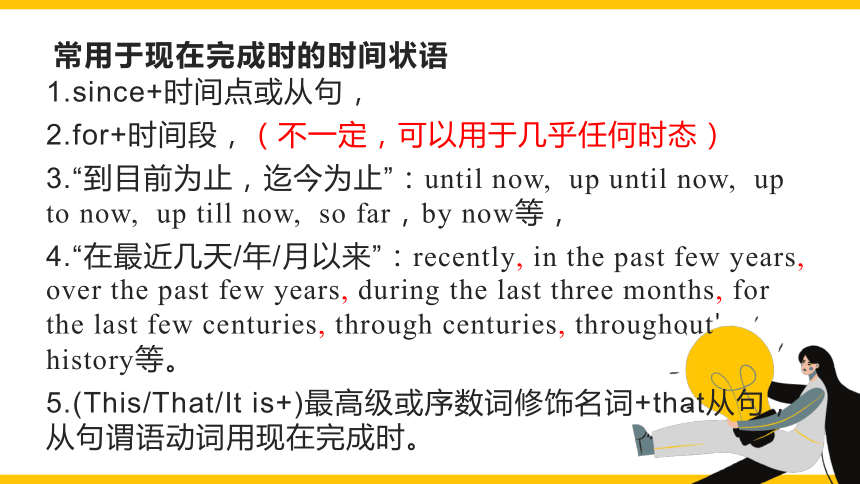20256届高考英语二轮复习 谓语动词 课件(19张)
文档属性
| 名称 | 20256届高考英语二轮复习 谓语动词 课件(19张) |  | |
| 格式 | pptx | ||
| 文件大小 | 1.1MB | ||
| 资源类型 | 教案 | ||
| 版本资源 | 外研版(2019) | ||
| 科目 | 英语 | ||
| 更新时间 | 2024-10-20 18:29:30 | ||
图片预览







文档简介
(共19张PPT)
谓语动词复习
01
时态
02
03
主谓一致
04
CONTENTS
语态
01
时态
现在 过去 将来
一般 write/writes am/is/are written wrote was/were written will write
will be written
进行 am/is/are writing am/is/are being written was/were writing was/were being written will be writing
完成 have/has written have/has been written had written had been written will have written
以write为例
一般时态和进行时态作用总结
1.一般现在时:表示习惯、常规、日常情况和客观事实
2.一般过去:陈述过去结束的事件
3.一般将来:描述将来的预测和预期、计划和提议
4.现在进行:描述某个动作这一刻或这一段时间正在发生
5.过去进行:描述过去某个特定时间正在发生的动作
6.将来进行:描述将来某个特定时间正在发生的动作
进行时都具有生动的场景感
现在完成时
主语+have/has done
现在完成时表示动作发生在过去,并持续到现在;
或者是过去的动作对现在的影响(影响反映在上下文的语境中)。
过去完成时
主语+had done
表示过去某个时间或某个动作之前,已经完成的动作;
或者表示从过去某个时间开始一直延续到过去另一个时间的动作。
将来完成时
主语+ will have done
表示在将来某时之前或某动作发生之前已经完成的动作;
表示一个持续到将来某时或某动作发生之前的动作。
完成时态作用总结
常用于现在完成时的时间状语
1.since+时间点或从句,
2.for+时间段,(不一定,可以用于几乎任何时态)
3.“到目前为止,迄今为止”:until now, up until now, up to now, up till now, so far,by now等,
4.“在最近几天/年/月以来”:recently, in the past few years, over the past few years, during the last three months, for the last few centuries, through centuries, throughout history等。
5.(This/That/It is+)最高级或序数词修饰名词+that从句,从句谓语动词用现在完成时。
如:1.This is the first time that I have come to Beijing.
2.He is the most handsome guy I have ever met in my life.
be动词若是was,that从句的谓语要用过去完成时。
e.g. This was the first time that I had come to Beijing.
一般过去时和现在完成时用于for+时间段的区别:
1) I have lived in China for three years.
2) I lived in China for three years.(一般有上下文)
1)现在还在中国居住,到目前为止已经生活三年,
往往还可能延续下去。
2)曾经在中国生活过三年,但现在不在中国。
过去完成时
用过去完成时要有一个过去的截止时间,在那之前就“有......过”,即开始于过去之前(过去的过去)。
完成时态的本质特征是回顾。现在完成时是站在“现在”回顾过去,过去完成时态是站在“过去”回顾“更远的过去”。
过去完成时态是一个不能独立存在的时态,必须依附于一个一般过去时态。先要有一般过去时态,才可能有过去完成时态。
She had made every thing before I came.
常用于过去完成时的时间状语
1.by+过去时间/by the time+过去时间:到过去某时为止
如:by the end of last week, by that time, before I arrived, before that year, when I arrived...
2.用于最高级句型
It was the+序数词(first,second...) time that...
It was the+最高级修饰名词+that从句
This was the first time that I had come to Beijing.
He brought the largest fish I had ever seen.
过去将来时
would+ do 和 was/were going to + do
表示在过去某时看来将要发生的动作或存在的状态,经常用于叙述过去的事情。
She said her mother would come to see her the next day.
她说她妈妈第二天要来看她。
She hoped that they would meet again someday.
她希望将来有一天他们能再见面。
02
语态
被动语态
形式:be动词+done(动词的过去分词)
被动语态的基本时态变化
被动语态可用于各种时态,其时态变化通过助动词be的不同形式来体现(把be done代入时态里面)
时态 动词的被动形式 例句
一般现在时 am/is/are done English is taught in most schools.
一般过去时 was/were done English was taught in most schools.
一般将来时 shall/will be done English will be taught in most schools (in the future).
现在进行时 am/is/are being done English is being taught in most schools.
过去进行时 was/were being done Engllish was being taught in most schools (at that time).
现在完成时 have/has been done English has been taught in most schools (recently).
过去完成时 had been done He said that English had been taught in most schools.
过去将来时 would be done He said English would be taught in most schools someday.
03
动词形式的变化
1.一般现在时(动词三单形式)
在一般现在时中,当主语是第三人称单数的时候,谓语动词要加s或者es.
1)普通情况:
2)当动词以s,x,sh,ch结尾时:
3)动词以辅音+y 结尾时:
4)不规则变化:have-has 有, are-is 是, do-does 做
go-goes
直接加s, put-puts 放
加es,kiss-kisses 亲吻 mix=mixes 混合 wash-washes 洗 watch-watches 观看 echoes
变y为i再加es:fly-flies 飞, reply-replies 回复
2.一般过去时(动词过去式)
1)普通情况:
2)以不发音的e结尾:
注意:ie结尾动词,直接加d: die-died;tie-tied.
3)
先双写结尾的辅音字母,再加-ed。如 refer, admit, stop, develop offer
4)以辅音字母加y结尾的动词:
直接在词尾加-ed。如: want—wanted, work—worked, need—needed, clean—cleaned
在词尾加-d。如:like—liked, live—lived, use—used, move—moved, smile--smiled
末尾只有一个辅音字母的重读闭音节词(辅+元+辅):
先把y变成i,再加-ed。如:study—studied, carry—carried, hurry—hurried, marry—married
3.现在进行时(动词现在分词形式,即doing或者V.ing)
1)一般情况:
2)动词以不发音的e结尾:
3)重读闭音节结尾(辅元辅结尾且重读)的动词:
4)以-ie结尾的动词,把ie变成y再加-ing
lie-----lying,tie-----tying,die-----dying
直接在动词后加-ing, work----working,sleep-----sleeping,study-----studying
要去e加ing, take-----taking,make-----making,dance-----dancing
要双写词尾字母,再加-ing,cut-----cutting, put-----putting, begin------beginning
Thanks!
谓语动词复习
01
时态
02
03
主谓一致
04
CONTENTS
语态
01
时态
现在 过去 将来
一般 write/writes am/is/are written wrote was/were written will write
will be written
进行 am/is/are writing am/is/are being written was/were writing was/were being written will be writing
完成 have/has written have/has been written had written had been written will have written
以write为例
一般时态和进行时态作用总结
1.一般现在时:表示习惯、常规、日常情况和客观事实
2.一般过去:陈述过去结束的事件
3.一般将来:描述将来的预测和预期、计划和提议
4.现在进行:描述某个动作这一刻或这一段时间正在发生
5.过去进行:描述过去某个特定时间正在发生的动作
6.将来进行:描述将来某个特定时间正在发生的动作
进行时都具有生动的场景感
现在完成时
主语+have/has done
现在完成时表示动作发生在过去,并持续到现在;
或者是过去的动作对现在的影响(影响反映在上下文的语境中)。
过去完成时
主语+had done
表示过去某个时间或某个动作之前,已经完成的动作;
或者表示从过去某个时间开始一直延续到过去另一个时间的动作。
将来完成时
主语+ will have done
表示在将来某时之前或某动作发生之前已经完成的动作;
表示一个持续到将来某时或某动作发生之前的动作。
完成时态作用总结
常用于现在完成时的时间状语
1.since+时间点或从句,
2.for+时间段,(不一定,可以用于几乎任何时态)
3.“到目前为止,迄今为止”:until now, up until now, up to now, up till now, so far,by now等,
4.“在最近几天/年/月以来”:recently, in the past few years, over the past few years, during the last three months, for the last few centuries, through centuries, throughout history等。
5.(This/That/It is+)最高级或序数词修饰名词+that从句,从句谓语动词用现在完成时。
如:1.This is the first time that I have come to Beijing.
2.He is the most handsome guy I have ever met in my life.
be动词若是was,that从句的谓语要用过去完成时。
e.g. This was the first time that I had come to Beijing.
一般过去时和现在完成时用于for+时间段的区别:
1) I have lived in China for three years.
2) I lived in China for three years.(一般有上下文)
1)现在还在中国居住,到目前为止已经生活三年,
往往还可能延续下去。
2)曾经在中国生活过三年,但现在不在中国。
过去完成时
用过去完成时要有一个过去的截止时间,在那之前就“有......过”,即开始于过去之前(过去的过去)。
完成时态的本质特征是回顾。现在完成时是站在“现在”回顾过去,过去完成时态是站在“过去”回顾“更远的过去”。
过去完成时态是一个不能独立存在的时态,必须依附于一个一般过去时态。先要有一般过去时态,才可能有过去完成时态。
She had made every thing before I came.
常用于过去完成时的时间状语
1.by+过去时间/by the time+过去时间:到过去某时为止
如:by the end of last week, by that time, before I arrived, before that year, when I arrived...
2.用于最高级句型
It was the+序数词(first,second...) time that...
It was the+最高级修饰名词+that从句
This was the first time that I had come to Beijing.
He brought the largest fish I had ever seen.
过去将来时
would+ do 和 was/were going to + do
表示在过去某时看来将要发生的动作或存在的状态,经常用于叙述过去的事情。
She said her mother would come to see her the next day.
她说她妈妈第二天要来看她。
She hoped that they would meet again someday.
她希望将来有一天他们能再见面。
02
语态
被动语态
形式:be动词+done(动词的过去分词)
被动语态的基本时态变化
被动语态可用于各种时态,其时态变化通过助动词be的不同形式来体现(把be done代入时态里面)
时态 动词的被动形式 例句
一般现在时 am/is/are done English is taught in most schools.
一般过去时 was/were done English was taught in most schools.
一般将来时 shall/will be done English will be taught in most schools (in the future).
现在进行时 am/is/are being done English is being taught in most schools.
过去进行时 was/were being done Engllish was being taught in most schools (at that time).
现在完成时 have/has been done English has been taught in most schools (recently).
过去完成时 had been done He said that English had been taught in most schools.
过去将来时 would be done He said English would be taught in most schools someday.
03
动词形式的变化
1.一般现在时(动词三单形式)
在一般现在时中,当主语是第三人称单数的时候,谓语动词要加s或者es.
1)普通情况:
2)当动词以s,x,sh,ch结尾时:
3)动词以辅音+y 结尾时:
4)不规则变化:have-has 有, are-is 是, do-does 做
go-goes
直接加s, put-puts 放
加es,kiss-kisses 亲吻 mix=mixes 混合 wash-washes 洗 watch-watches 观看 echoes
变y为i再加es:fly-flies 飞, reply-replies 回复
2.一般过去时(动词过去式)
1)普通情况:
2)以不发音的e结尾:
注意:ie结尾动词,直接加d: die-died;tie-tied.
3)
先双写结尾的辅音字母,再加-ed。如 refer, admit, stop, develop offer
4)以辅音字母加y结尾的动词:
直接在词尾加-ed。如: want—wanted, work—worked, need—needed, clean—cleaned
在词尾加-d。如:like—liked, live—lived, use—used, move—moved, smile--smiled
末尾只有一个辅音字母的重读闭音节词(辅+元+辅):
先把y变成i,再加-ed。如:study—studied, carry—carried, hurry—hurried, marry—married
3.现在进行时(动词现在分词形式,即doing或者V.ing)
1)一般情况:
2)动词以不发音的e结尾:
3)重读闭音节结尾(辅元辅结尾且重读)的动词:
4)以-ie结尾的动词,把ie变成y再加-ing
lie-----lying,tie-----tying,die-----dying
直接在动词后加-ing, work----working,sleep-----sleeping,study-----studying
要去e加ing, take-----taking,make-----making,dance-----dancing
要双写词尾字母,再加-ing,cut-----cutting, put-----putting, begin------beginning
Thanks!
